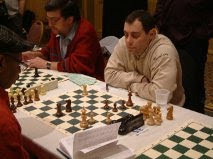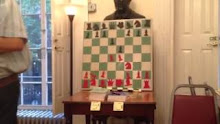Dragan Milovanovic (USCF 2220) - Jim West (USCF 2200), Hamilton NJ Quad 3/24/2007
1.e4 c5 2.Nf3 d6 3.d4 cxd4 4.Nxd4 Nf6 5.Nc3 a6
This used to be my favorite defense against 1.e4. I still play it occasionally, especially against players who prefer 6.Bg5.
6.Bg5 e6 7.f4 Be7 8.Qf3 Qc7 9.O-O-O Nbd7 10.Bd3 b5 11.Rhe1 Bb7 12.Qg3 O-O-O 13.Bxf6
For 13.Bxb5!, see my blog post of 2/8/2007.
13...Nxf6 14.Qxg7 Rdf8 15.Qg3 b4 16.Na4 Rhg8 17.Qf2
One month earlier at the same location, Dragan played less precisely with 17.Qf3 but won anyway after I unwisely brought my king to d7 on move 23 rather than to the safer square b8.
17...Nd7 18.Kb1 Kb8 19.c3 Nc5 20.Bc2 bxc3 21.Nxc3 Bf6 22.g3 h5
As you can see, both players did their homework since the previous month's game, reaching this critical position from the famed Spassky-Fischer encounter which ended in a draw by perpetual check after 43 moves.
23.Qe2
Spassky played the much weaker 23.e5? and was fortunate to survive Fischer's attack after 23...dxe5 24.fxe5 Bh8! 25.Nf3 Rd8 26.Rxd8+ Rxd8 27.Ng5? Bxe5 28.Qxf7 Rd7 29.Qxh5?! Bxc3! 30.bxc3 Qb6+.
In Both Sides of the Chessboard, Robert Byrne and Ivo Nei recommend 23.Re3! as White's best continuation. Dragan's move encourages Black to play 23...h4, but I did not like the looks of 24.g4 followed by 25.g5. Remembering how Spassky had gotten into trouble after playing Qxh5, I decided not to guard the h-pawn.
23...Qb6 24.e5 dxe5 25.fxe5 Bh8 26.Qxh5 f6!?
This is no time to count material! Black must open lines toward White's king as quickly as possible.
27.Nb3 Nxb3 28.Bxb3 fxe5 29.Ne4
Quite correctly, White blocks the advance of the e5 pawn which is intent upon sacrificing itself to open the diagonal for Black's bishop on h8.
29...Rd8 30.Rxd8+ Rxd8 31.Qh4 Qd4 32.Bc2 Rc8 33.Rd1 Qc4 34.Bd3 Qd4 35.Qh7?!
After the game, Dragan criticized this move. Probably White should repeat the position by 35.Bc2 Qc4 36.Bd3, etc.
35...Bd5!
Among other things, this shot threatens 36...Bxa2+!.
36.Nc3??
I had expected 36.b3 a5!?.
36...e4!!
Now the dormant bishop on h8 springs to life, deciding the outcome of the game.
37.Bxe4 Qb4 38.Bxd5 exd5 39.a3 Qb3 40.Qc2 Rxc3!
Winning a piece and the game!
41.Qxb3+ Rxb3 42.Rxd5 Rxb2+ 43.Kc1 Rxh2
The endgame is an easy win for Black because the bishop controls the a-pawn's queening square.
44.Kd1 Kb7 45.Ke1 Ra2 46.Rd3 Bb2 47.Rb3+ Ka7 48.g4 Bxa3 49.g5 a5 50.g6 Bb4+ 51.Kf1 Rc2 52.Rg3 Rc8
My rook arrives at the back rank, just in the nick of time.
53.Ke2 Kb6 54.Kd1 Rg8 55.Kc2 Kc5 56.Kb3 Kd5 57.Ka4 Ke5 58.Rg1 Kf6 59.Rf1+ Kxg6
If my bishop did not control the queening square, White could now force a draw by 60.Rg1+ Kf7 61.Rxg8 Kxg8.
60.Ra1 Rb8 61.Rb1 Kf5 62.Rf1+ Ke6 63.Rb1 Kd5 64.Rh1 Kc6 65.Rh6+ Kc7 66.Rh7+ Kb6 67.Rh6+ Ka7 68.Re6 Rb6 69.Re8 Rh6 70.Rg8 Kb7 71.Kb5 Rh5+ 72.Ka4 Bd6
The bishop is needed to shield Black's king from checks.
73.Rg6 Bc7 74.Rg4 Ka6 75.Rg6+ Bb6 76.Rg4 Rd5 77.Rg3 Rd4+, White resigns.




























